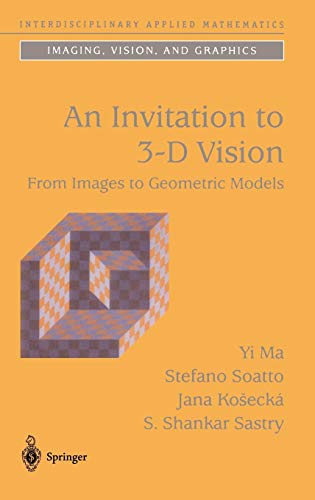 Reddit reviews An Invitation to 3-D Vision: From Images to Geometric Models (Interdisciplinary Applied Mathematics (26))
Reddit reviews An Invitation to 3-D Vision: From Images to Geometric Models (Interdisciplinary Applied Mathematics (26))
We found 3 Reddit comments about An Invitation to 3-D Vision: From Images to Geometric Models (Interdisciplinary Applied Mathematics (26)). Here are the top ones, ranked by their Reddit score.

If anyone is interested in delving a bit more into this kind of algorithm, and particularly the math behind it, I highly recommend this book.
It's a bit dense, but if you have the patience and want to understand the math, it covers pretty much everything relevant.
Is this the book you're referring to: https://www.eecis.udel.edu/~cer/arv/readings/old_mkss.pdf / https://www.amazon.com/Invitation-3-D-Vision-Interdisciplinary-Mathematics/dp/0387008934/
I just want to make sure before I make a purchase.
sure is! Funny thing about applied calculus though... like, think back to your fundamental theorem of calculus. What IS an integral? One way of thinking of it, is you're taking all these infinitely tiny pieces and adding them all up together to get a sum (your total volume in this case). For you to use integration with a parametrized function, you can take the full infinite sum that is the integral, but in real life, it's often not practical to work like that. As you pointed out, how would you parametrize a fruit? You could approximate it of course... maybe some almost-spherical ellipsoid could be an orange or something, but what about the top part? What about the bumps?
In practice, you often use what's called a numerical approximation instead. The idea is that instead of taking the 'true' integral, you just approximate it by taking a bunch of tiny (but not infinitely) tiny pieces, and then do it that way. For a lot of more complicated problems, that's the only way to do it, because it's literally impossible to solve it analytically (the equations can't be solved directly). Fluid simulations for instance, you might use 'voxels' (think minecraft) and discrete time steps (say, .01 seconds) and then march the simulation forward, solving in each little voxel at t=.01, then solve at each voxel for t=.02, and eventually, after an ungodly amount of time, you have a cool video like this! You need to use all kinds of tricks to try and make sure errors don't compound over time and that it runs as quick as possible, but the idea is that you approximate the 'true' solution by using tiny slices, kind of like you're 'almost' taking the limit to infinity. You're taking it down to the smallest pieces you can afford, given your computer budget. That's roughly how they do weather prediction and climate modeling.
so, one way to approximate the volume of a fruit, would be to do it minecraft style... get all the voxels that would be filled if you had a giant fruit in minecraft, figure out the relative scale of each voxel (say, 1mm^3 ) and then just... add up all the voxels to get your full volume.
There's a lot of ways to extract 3D data from an object though. In the field I'm interested in, you tend to either get point clouds, voxels, or (potentially, though it's much harder to extract) full 3D meshes, suitable for 3D printing or videogames or whatever. There are different ways to get the scan data in too... photogrammetry is the name for one family of techniques, the idea is that given a bunch of photos from all sides of an object, you can figure out the shape of that object in 3D space. You can see some examples of what that can look like here. There's some CRAZY math that all gets into... enough to fill a book just for the introduction, haha. And that doesn't even start to get into the current state of the art machine learning methods... but either way, the eli5 version is that you're doing an approximation. It's usually much more convenient to work with an approximate representation of the object (a 3D model or voxels or something) than it is to try and parametrize it into a form you can do calculus with. Even if you could, you're unlikely to get a function you'd be able to integrate anyway, integration gets messy when you're dealing with complicated functions. Good stuff to be thinking about though, and the fundamental ideas of what integration 'is' will need to be understood if you're going to get how approximation methods like this work, so you're on a good line of thinking.